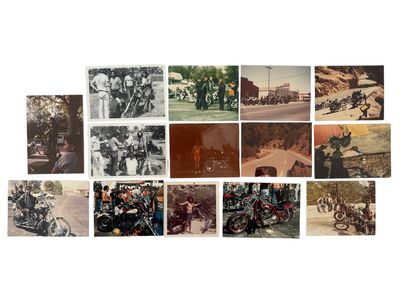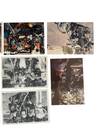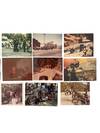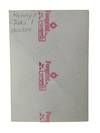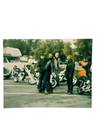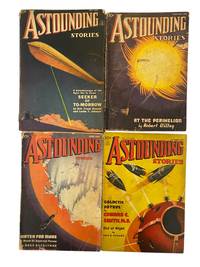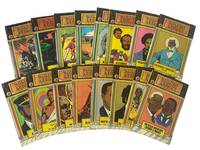by Bikers, California
Outlaw biker scene in California photo archive. Mid 1970s. Consists of 14 vernacular photographs (12 color, 5 black-and-white) primarily taken between 1972 and 1976. This evocative photo archive offers a rare glimpse into the grassroots subculture of Southern California outlaw bikers in the early to mid-1970s, a pivotal period when the iconography of American motorcycle clubs—centered on choppers, denim, leather, and camaraderie—cemented itself into pop counterculture. The archive captures a tight-knit group of predominantly male riders at various stages of the biker lifestyle: gathered under trees wrenching on bikes, posed roadside with engines idling, and staged beside heavily customized Harley-Davidson motorcycles. A few images bear handwritten annotations on verso, including names “Kenny,” “Jodi,” and “Scoot,” with one print dated July 1976. Most prints measuring approx. 3.5 x 5 in., with some slight variation.
One black-and-white image shows five men in conversation, one shirtless and hunched over a classic hardtail chopper, possibly a Harley Panhead or Knucklehead, stripped down with extended forks, peanut tank, ape hanger handlebars, and a sissy bar. These are home-built machines often devoid of front brakes or turn signals, consistent with the anti-establishment ethos of the time. Another standout image features a flame-painted Harley, likely a Shovelhead, parked outside a bike show or run, surrounded by men and women in sleeveless vests and tank tops. Several men wear denim vests or leather jackets with patches, though none clearly indicate major club affiliations. The lack of full rockers may suggest a non-patched independent club or unaffiliated riders. One group portrait shows five riders standing beside their bikes in a parking lot, two sporting red bandanas and long beards.
The California biker scene in the early 1970s represented a complex intersection of post-Vietnam disaffection, working-class identity, and anti-authoritarianism. Clubs and loose riding groups like those depicted here often consisted of veterans, Latinos, Native Americans, and working-class whites alienated from mainstream American life. This visual archive, marked by its candid informality and rich detail, is especially notable for its social realism: the hand-built motorcycles, shirtless mechanics, and unguarded roadside hangs document not the myth but the lived reality of 1970s outlaw biker life. Light surface wear and corner rubbing to some prints; one image shows minor staining; overall well-preserved and sharp. (Inventory #: 21753)
One black-and-white image shows five men in conversation, one shirtless and hunched over a classic hardtail chopper, possibly a Harley Panhead or Knucklehead, stripped down with extended forks, peanut tank, ape hanger handlebars, and a sissy bar. These are home-built machines often devoid of front brakes or turn signals, consistent with the anti-establishment ethos of the time. Another standout image features a flame-painted Harley, likely a Shovelhead, parked outside a bike show or run, surrounded by men and women in sleeveless vests and tank tops. Several men wear denim vests or leather jackets with patches, though none clearly indicate major club affiliations. The lack of full rockers may suggest a non-patched independent club or unaffiliated riders. One group portrait shows five riders standing beside their bikes in a parking lot, two sporting red bandanas and long beards.
The California biker scene in the early 1970s represented a complex intersection of post-Vietnam disaffection, working-class identity, and anti-authoritarianism. Clubs and loose riding groups like those depicted here often consisted of veterans, Latinos, Native Americans, and working-class whites alienated from mainstream American life. This visual archive, marked by its candid informality and rich detail, is especially notable for its social realism: the hand-built motorcycles, shirtless mechanics, and unguarded roadside hangs document not the myth but the lived reality of 1970s outlaw biker life. Light surface wear and corner rubbing to some prints; one image shows minor staining; overall well-preserved and sharp. (Inventory #: 21753)
